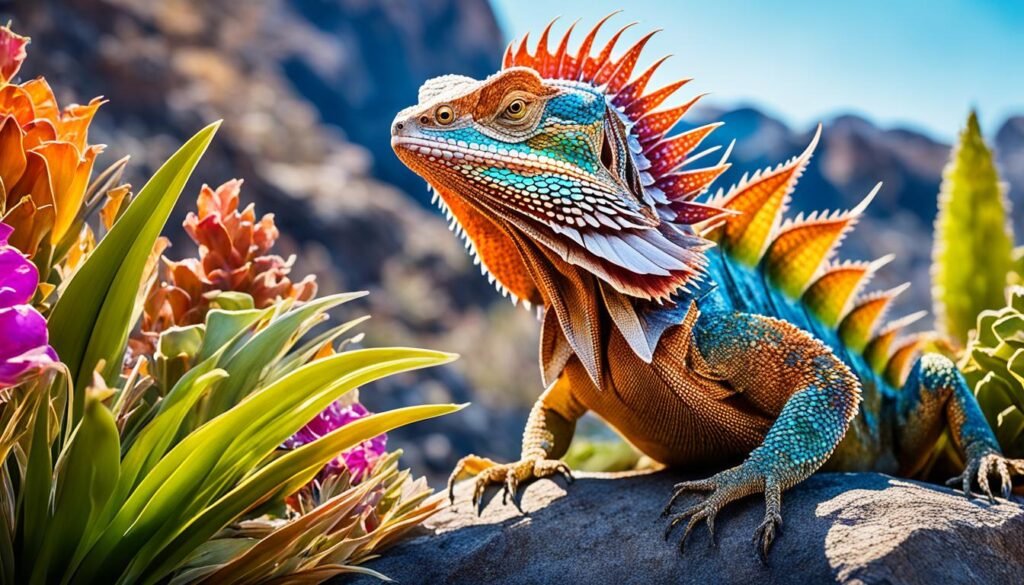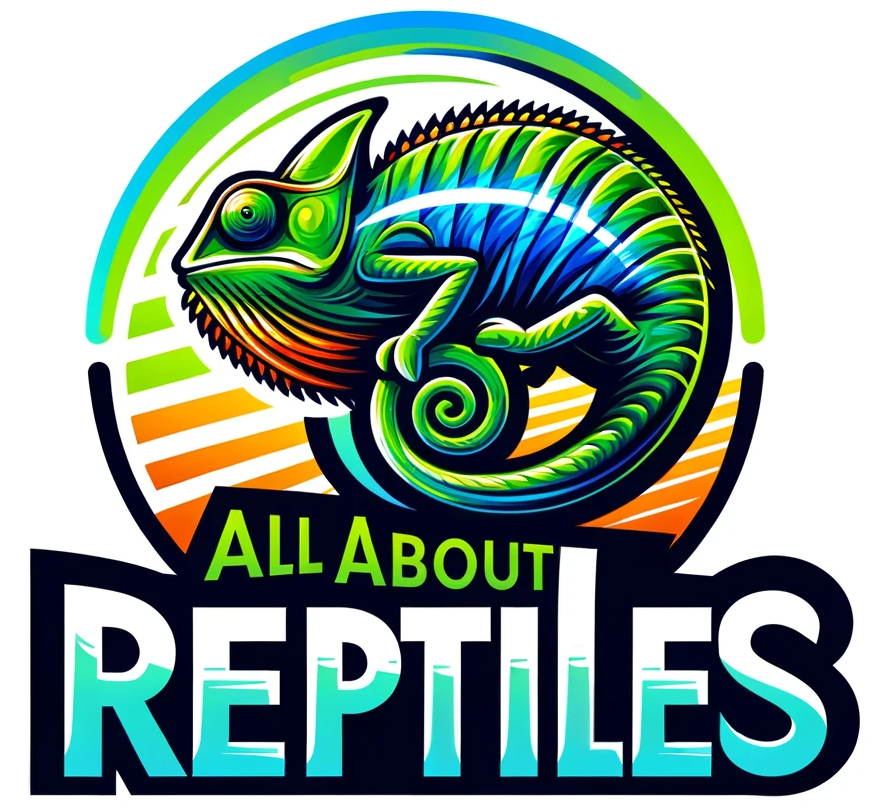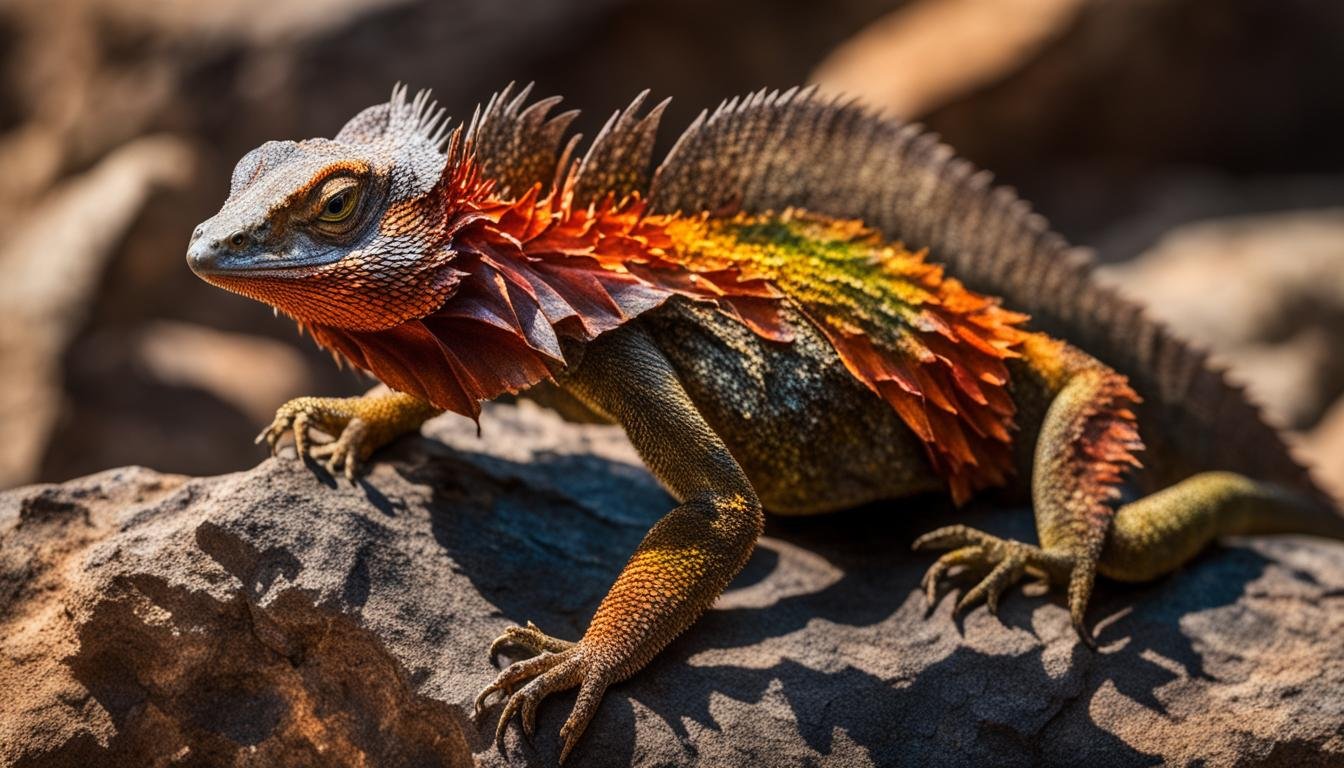Did you know that the frilled lizard, also known as the frill-necked lizard, has a unique defense mechanism that allows it to intimidate predators? When threatened or surprised, this remarkable reptile extends a large frill of skin around its neck, creating a display that is truly awe-inspiring.
In this comprehensive care guide, I will dive into the fascinating world of frilled lizards, exploring their natural history, housing requirements, heating and lighting needs, decoration options, diet and water requirements, breeding considerations, and cleaning needs. By the end of this guide, you’ll have a thorough understanding of how to provide the best care for these unique Australian lizards and help them thrive in captivity.
Key Takeaways:
- Frilled lizards have a distinctive frill around their neck that they extend as a defense mechanism.
- These reptiles require specific housing conditions, including a warm environment and adequate space for climbing and hiding.
- The temperature and UVB lighting in their enclosure should be carefully regulated to mimic their natural habitat.
- Frilled lizards have a primarily insectivorous diet and require supplementation to meet their nutritional needs.
- Providing a source of fresh water and creating a beneficial environment with appropriate decorations are essential for their well-being.
Natural History of Frilled Lizards
Frilled dragons, also known as frill-necked lizards, are fascinating reptiles native to northern Australia and southern New Guinea. These Australian lizards have captured the attention of reptile enthusiasts with their unique frilled necks and arboreal lifestyle.
Frilled lizards are well-adapted to their habitat, which primarily consists of warm temperate dry forests and semi-arid grassy woodlands. They prefer areas with tall trees and interlocking branches, providing them with the perfect environment for their arboreal lifestyle.
In their natural habitat, frilled lizards are commonly found in humid climates, such as the tropical savannah woodland. These reptiles thrive in the lush foliage of the woodland, utilizing their excellent climbing abilities to navigate the trees and find shelter.
Frilled lizards are primarily insectivorous, with their diet mainly comprising of insects and small lizards. Their agility and quick reflexes enable them to capture their prey with precision, making them formidable hunters in their ecosystem.
| Habitat | Prey |
|---|---|
| Warm temperate dry forests | Insects |
| Semi-arid grassy woodlands | Small lizards |
| Tropical savannah woodland |
Frilled lizards’ natural history and habitat showcase their incredible adaptability and unique characteristics. Understanding their native environment is essential for providing suitable care and ensuring their well-being in captivity.
Housing for Frilled Lizards
Frilled lizards require a warm and spacious environment to thrive. To provide them with a suitable habitat, I recommend using a wooden vivarium with proper ventilation. The vivarium should be as close to 4 x 2 x 3ft in size as possible, ensuring that frilled lizards have ample space to move around. Large vents and glass sliding front doors can help maintain the necessary airflow within the enclosure.
Creating a temperature gradient is essential for frilled lizard care. This can be achieved by setting up a warm basking spot on one side of the enclosure and a cooler section on the other. The temperature in the basking area should be around 100°F, while the cooler side should be maintained at around 80°F. A thermometer can be used to monitor and adjust the ambient temperature levels accordingly.
As frilled lizards grow, it is important to regularly evaluate and adjust the enclosure’s decorations to accommodate their increasing size. Gradually removing or replacing bulky decorations will prevent any potential injuries or obstacles to their movement.
In summary, providing a spacious wooden vivarium with ventilation, a temperature gradient, and room for growth is crucial for the well-being of frilled lizards.
Heating for Frilled Lizards
Frilled lizards require a warm basking area with a temperature of 100°F during the day. To achieve this, it is essential to provide the right heating setup in their enclosure. Here’s what you need to know:
- Basking Area: Create a designated basking area in the enclosure where your frilled lizard can soak up the heat. This area should be equipped with a basking lamp to provide the necessary warmth.
- Ceramic Lamp: A ceramic lamp is an excellent option for providing gentle warmth to the enclosure without introducing additional light. This is especially important for maintaining the lizard’s natural day and night cycle.
- Dimming Thermostat: To regulate the temperature in the basking area, use a dimming thermostat. This device will automatically adjust the power output of the basking lamp to maintain a consistent temperature.
It is crucial to monitor the temperatures within the enclosure to ensure they remain within the appropriate range. Use a thermometer to regularly check the basking area temperature and make adjustments as needed. Remember, maintaining the right heating conditions is essential for the well-being and overall health of your frilled lizard.
UVB Lighting for Frilled Lizards

Frilled lizards require proper UVB lighting to ensure their health and well-being. UVB light helps these reptiles absorb calcium from their diet and synthesize vitamin D3, which is essential for proper bone growth and overall metabolic functions.
To provide adequate UVB lighting for your frilled lizard, consider the following:
- Use a 10% UV tube that covers at least 2/3 of the length of the enclosure. This will ensure that the lizard receives sufficient UVB exposure.
- UV tubes are available in two sizes: T8 and T5. While both types can be used, T5 lamps are newer and more efficient. They provide a higher UVB output and are recommended for frilled lizards.
- If you have a tall enclosure, it is recommended to mount a T5 UVB unit to the ceiling, close to the back wall. This will create a UV gradient, allowing the lizard to choose the level of UV exposure it needs.
Remember to provide hiding spots within the enclosure, as frilled lizards may seek shade when desired. These hiding spots can be created using rocks, branches, or artificial plants. They will allow the lizard to regulate its UVB exposure and protect itself from excessive light.
Below is an example of a comparison table between T8 and T5 UVB lamps:
| T8 UVB Lamp | T5 UVB Lamp |
|---|---|
| Lower UVB output | Higher UVB output |
| Less energy-efficient | More energy-efficient |
| Suitable for shorter enclosures | Suitable for taller enclosures |
Decoration for Frilled Lizards

Creating a visually appealing and naturalistic enclosure for your frilled lizards is essential for their well-being. Here are some key elements to consider when decorating their habitat:
Substrate
Choose a substrate that provides both moisture retention and climbing opportunities. A mixture of coarse bark woodchips and soil/moss can create the ideal base for your frilled lizard’s enclosure. This combination provides a naturalistic feel while allowing them to dig and burrow.
Hard Wood Decorations
Frilled lizards love to climb and perch on various surfaces. Introducing hard wood decorations, such as grapevine or lliana pieces, near the warm end of the enclosure allows them to exhibit their arboreal nature. However, be cautious not to place these decorations too close to the basking lamp to prevent overheating.
Rocks
Natural rocks, such as slate, can serve multiple purposes in your frilled lizard’s habitat. They not only provide additional belly heat when warmed by heat sources but also create interesting hiding spots and basking areas. Just ensure that the rocks are securely positioned to prevent any injury to your lizard.
Hiding Spots
Frilled lizards appreciate privacy and the ability to escape from bright light when needed. It is important to include both full and partial hiding spots throughout the enclosure. This can be achieved by incorporating caves, branches, and dense foliage. These hiding spots create a sense of security for your frilled lizards and allow them to regulate their exposure to light and heat.
| Decoration | Purpose |
|---|---|
| Coarse bark woodchips and soil/moss mix | Provides moisture retention and digging opportunities |
| Hardwood decorations (grapevine or lliana pieces) | Allows climbing and perching opportunities |
| Natural rocks (slate) | Offers additional belly heat and creates hiding spots |
| Hiding spots (caves, branches, dense foliage) | Provides privacy and regulates exposure to light and heat |
Diet & Water for Frilled Lizards
Frilled lizards have a primarily insectivorous diet and should be fed a variety of live insects to meet their nutritional needs. Some suitable options include crickets, dubia roaches, mealworms, and hornworms. These insects should be gut-loaded prior to feeding to ensure they provide proper nutrition to the lizards. Additionally, it’s essential to dust the insects with calcium and vitamin powders before offering them to the lizards to ensure they receive the necessary nutrients.
Although insects form the majority of their diet, frilled lizards can also consume small mammals and fish occasionally. These additional food sources can provide variety and enrichment to their diet. It’s important to note that such prey items should be appropriately sized and safe for consumption.
Hydration is crucial for frilled lizards’ overall well-being. While they primarily obtain water from droplets found on leaves and within their environment, providing a large water bowl in their enclosure is essential. The water bowl not only serves as a source of hydration but also allows the lizards to bathe or cool down if desired. Ensure that the water is clean and changed regularly to promote good hygiene.
In addition to their diet, it’s vital to provide fresh, clean water in a readily accessible location. This will help ensure that the frilled lizards remain hydrated and maintain their overall health.
Supplements for Frilled Lizards
While frilled lizards can obtain most of their required nutrients from their diet, supplements play a crucial role in providing higher concentrations of essential vitamins and minerals. Calcium and vitamin powders are recommended additions to ensure the optimal health of frilled lizards.
These supplements can be dusted onto their food, ensuring that they receive the necessary nutritional boost. Calcium is vital for strong bones and egg production in females, while vitamin powders help support overall immune function and metabolic processes.
When choosing supplements for frilled lizards, it is important to consider the UVB levels in their enclosure. UVB lighting enables lizards to absorb calcium and synthesize vitamin D3 naturally. Depending on the UVB levels, you may need to select supplements that include or exclude synthetic vitamin D3.
Regular monitoring of the UVB levels is essential to ensure that your frilled lizard is receiving the right balance of UVB radiation and supplementation. This ensures proper calcium metabolism and prevents issues like metabolic bone disease.
By providing the appropriate supplements, you can enhance the nutritional profile of your frilled lizard’s diet, promoting their overall well-being and longevity.
Varieties of Supplements for Frilled Lizards
There are several reputable brands that offer specially formulated supplements for reptiles, including frilled lizards. It’s essential to choose a high-quality product that meets the nutritional requirements of your lizard.
- Calcium supplements: Look for a calcium powder with added vitamin D3 if your frilled lizard has limited UVB exposure in its enclosure.
- Vitamin D3 supplements: These supplements can be beneficial for lizards with limited or no access to UVB light. However, it’s crucial to consult with a reptile veterinarian before using vitamin D3 supplements.
- Multi-vitamin supplements: These products offer a blend of essential vitamins and minerals, providing a comprehensive nutritional boost for your frilled lizard.
Remember, supplementation should never replace a balanced diet. Along with supplements, it’s crucial to offer a variety of insects and small mammals as part of your frilled lizard’s daily meals. This ensures a well-rounded diet that meets their nutritional needs.
Conclusion
Frilled lizards are truly unique reptiles with captivating characteristics. From their frilled necks to their agile hind leg locomotion and arboreal lifestyle, these lizards are a fascinating species to care for. By providing them with the appropriate housing, heating, UVB lighting, decoration, diet, water, and supplements, frilled lizards can flourish in captivity.
Understanding their natural history and replicating their native habitat is crucial in ensuring their well-being. Creating a warm and spacious wooden vivarium, maintaining a temperature gradient, and using appropriate heating and lighting sources are essential for their health. Additionally, providing a substrate and decorations that mimic their natural environment, such as coarse bark woodchip or soil/moss mix, and natural rocks, will offer them a sense of security and stimulation.
Frilled lizards have specific dietary requirements, primarily consisting of live insects like crickets and dubia roaches. To ensure their optimal health, it is important to supplement their diet with calcium and vitamin powders. Paying attention to their UVB levels and providing them with a balanced diet will contribute to their overall well-being.
With the right care, patience, and attention, frilled lizards can lead a healthy and fulfilling life in captivity. Taking the time to understand their unique characteristics and providing them with a suitable environment will allow these remarkable reptiles to thrive.
FAQ
What is a frilled lizard?
What makes frilled lizards unique?
Where do frilled lizards live?
How should I house my frilled lizard?
How do I provide heating for my frilled lizard?
What kind of UVB lighting do frilled lizards need?
What decorations should I provide for my frilled lizard?
What should I feed my frilled lizard?
Do frilled lizards require supplements?
How can I ensure the well-being of my frilled lizard?
References
| Organization Name | URL |
|---|---|
| International Reptile Conservation Foundation (IRCF) | https://www.ircf.org/ |
| Herpetological Conservation International | https://herpconservation.com/index.html |
| Society for the Study of Amphibians and Reptiles (SSAR) | https://ssarherps.org/conservation/conservation-resources/ |


1 thought on “Frilled Lizard Facts & Care Guide – Discover Now”